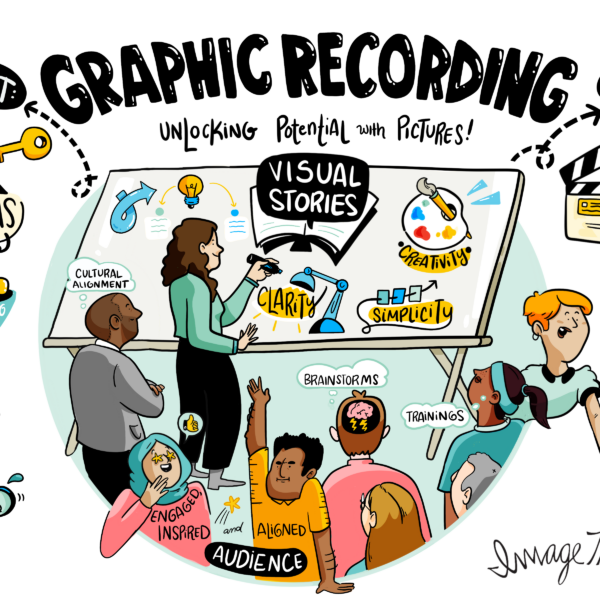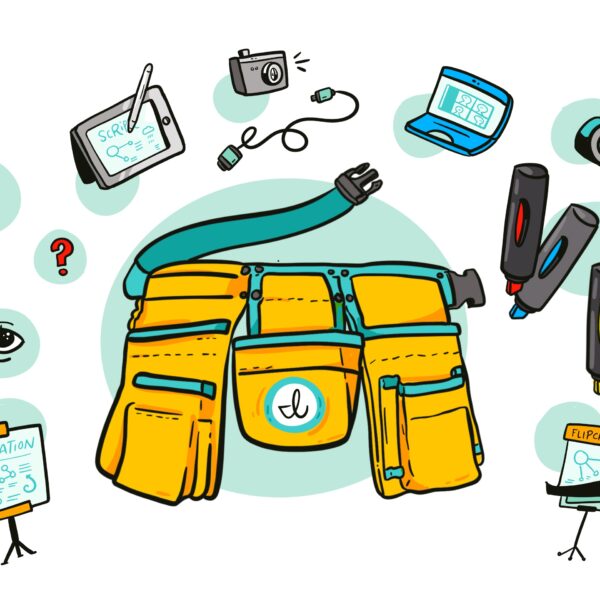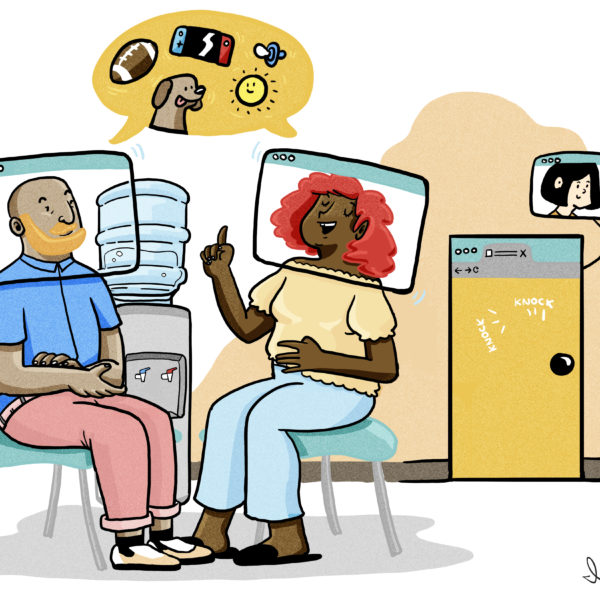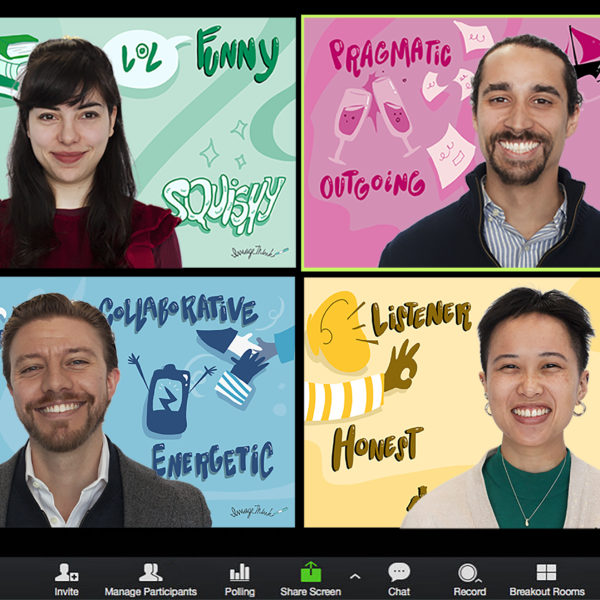As a graphic recording and graphic facilitation firm, ImageThink has provided visual support in countless meetings and workshops. As such, our visual strategists have experienced firsthand how icebreakers can either set the stage for a dynamic session or leave everyone feeling awkward. Beyond introductions, icebreakers should energize a room, build connections, and pave the way for meaningful discussions. Unfortunately, more often than not, they fall short of this goal, causing the room’s energy to fizzle out.
So, how do you avoid this pitfall, and leverage icebreakers in a way that sparks collaboration and creativity? Read on to learn more about this valuable meeting tool, why it matters, and to discover the framework ImageThink has used to craft successful icebreakers for years on end.
What is an icebreaker?
An icebreaker is a warmup activity that is deployed at the start of a meeting or in a group setting. These activities aim to ease attendees into a session by stimulating energy, creativity, or collaboration. Icebreakers traditionally take on the form of a question, physical activity, or creative exercise. Typically, icebreakers are tailored to a meeting’s objectives, size, or duration.
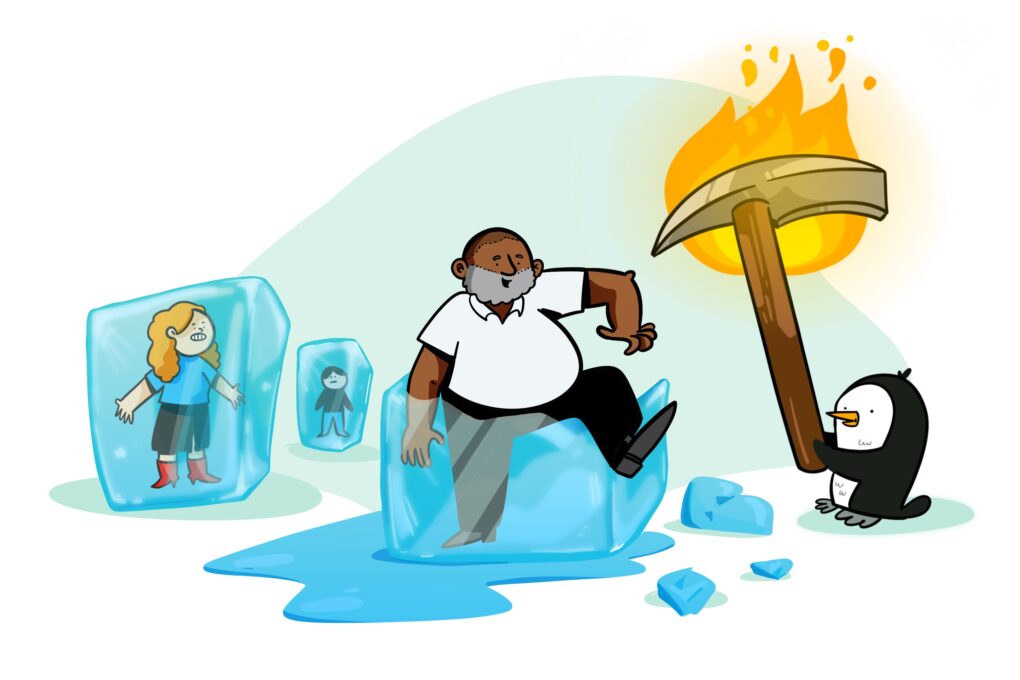
Why icebreakers matter
For many, icebreakers have become synonymous with a dreaded task a group must do while meeting each other for the first time, or in order to get to the stuff that’s actually valuable. On the contrary, when used strategically, icebreakers set the tone for dynamic, productive sessions.
Icebreakers are more than just a way to kick off a meeting – they are essential for creating a positive atmosphere and space where individuals feel comfortable contributing. These activities build rapport and trust among team members, which is necessary for effective teamwork and collaboration.
Successful icebreakers encourage contributions, foster connections, and generate meaningful discussions. On the other hand, poorly executed icebreakers can actively vacuum the energy out of a room and leave participants feeling deflated. This highlights the importance of this meeting tool, and why it’s crucial to design activities that genuinely resonate with attendees. We’ve developed a framework – I.C.E.S. – to ensure your icebreakers are as effective as possible.
The I.C.E.S. Framework
The I.C.E.S. Framework is designed to help you craft icebreakers that are informative, creative, exchange-focused, and scalable. Putting this framework to use will ensure your icebreakers spark not just conversation, but real collaboration. Read more about the framework below:
I. Informative: Icebreakers should provide valuable insights or information relevant to the session’s objectives. For example, ImageThink once supported a branding session in which we kicked the meeting off by asking participants to share a brand they loved. This simple prompt sparked insightful discussions about brand loyalty and what makes a brand memorable.
More importantly, it got participant’s wheels churning about the kinds of qualities that resonate most with consumers, which set the stage for innovative ideas and constructive dialogue.
C. Creative: Injecting creativity into icebreakers can make them more engaging and memorable. Instead of traditional questions, consider prompts that encourage participants to express themselves uniquely. This not only breaks the ice, but also cultivates openness and creativity right from the start.
E. Exchange-focused: Strong icebreakers facilitate genuine exchange amongst participants. Whether it’s sharing personal experiences, discussing relevant topics, or learning something new about each other, these interactions lay the groundwork for collaborative and productive sessions.
S. Scalable: Consider time constraints and group dynamics. The best icebreakers are tailored to fit meeting agendas and durations. For longer sessions, starting with a brief, energizing activity can set a positive tone without monopolizing valuable meeting time.
Practical tips for crafting engaging icebreakers
Want to break the ice at your next meeting? Preparation, variety, and relevancy are all invaluable tools for crafting engaging icebreakers.
Taking the time to prepare your icebreakers in advance of a meeting ensures they’ll land among participants. In preparation, you should consider meeting objectives and participant interests. Understanding your audience and anticipating their needs will ensure that your icebreakers are engaging, and relevant.
Shaking things up can be as simple as incorporating a mix of formats into icebreaker activities. Pair discussions, group activities, or virtual tools all offer fresh variety for participants, and are effective at keeping them involved and engaged. These formats, when used correctly, can be equally beneficial in hybrid and virtual settings as well, giving participants unique ways to collaborate with one another.
Lastly, keep your icebreakers relevant. A strategic linkage to the meeting agenda or broader organizational goals ensures these activities contribute to meeting outcomes and foster productive discussions. If there’s one thing you take from this article, let it be this.
Break the ice
Effective ice breakers can transform the atmosphere of any meeting or workshop. They set a positive tone, foster collaboration, and stimulate creative thinking. By following the I.C.E.S Framework, you can make your sessions more engaging and productive – and in turn, create more meaningful outcomes for your team.
Want to break the ice at your next meeting or workshop? Click here to learn more about ImageThink’s graphic facilitation or get in touch with us today to explore support options for your next engagement.
